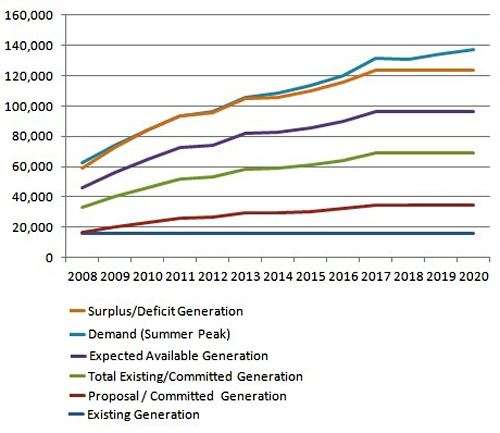Apr 14, 2025
Apr 14, 2025
Pakistan is in the grip of a serious energy crisis that is affecting all sectors of the economy and the various segments of the society. Luckily Pakistan has blessed by many types of resources but lack of attention and sincerity among authority leaders and concerned department all resources are just for name of appreciations rather than utilization.

For years, the matter of balancing Pakistan's supply against the demand for electricity has remained a largely unresolved matter. Pakistan faces a significant challenge in revamping its network responsible for the supply of electricity.
Pakistan’s energy infrastructure is not well developed, to a certain extent it is considered to be underdeveloped and poorly managed. Currently the country is facing severe energy crisis. Even despite the fact that of strong economic growth, rising energy demand during past decade, no serious efforts have been made to install new capacity of generation.
Besides, rapid demand growth, transmission losses due to outdated infrastructure, power theft, and seasonal reductions in the availability of hydropower have worsened the situation. Consequently, the demand exceeds supply and hence load-shedding is a common phenomenon through power shutdown. The power cuts during this time amounted to 20-22 hours a day in most small cities and even cities like Karachi were seeing 18+ hours of load shedding.
Pakistan needs around 15,000 to 20000 MW electricity per day, however, currently it is able to produce about 11,500 MW per day hence there is a shortfall of about 4000 to 9000 MW per day.
According to an official report, the gap between firm supply and peak hours demand has already been shrunk to three digit (440 MW) during this fiscal and will slip into negative columns next year (-441 MW) and further intensify to (-1,457 MW) during the financial year 2006-07.
The report maintained that the difference between firm supply and peak demand is estimated at 5,529 MW by the year 2009-10 when firm electricity supply will stand at 15,055 MW against peak demand of 20,584 MW.
The National Assembly Standing Committee for Water and Power meeting was held in Islamabad under the chairmanship of Ghulam Mustafa Shah.Briefing the committee, Water and Power Development Authority Chairman Shakil Durrani said that Mangla Dam would be filled up to 1210 feet by the end of this year. This will enhance the water storing capacity of the dam by 0.8 million acres.
The WAPDA chairman said that load shedding cannot be overcome until 2018 and power demand would soar to 130,000 megawatt by 2030.
He said that India could not build dams on three western rivers, adding that the 16 kilometer long tunnel of Jhelum Hydro Project had been constructed.
During 2010 Pakistan floods and 2005 Kashmir earthquake power stations, power distribution and transmission and other energy infrastructures were damaged. During the floods the recently constructed Jinnah hydroelectric power plant was flooded in addition to severe damages to transmission and distribution network and installations while several power plants and refineries were threatened by rising waters and had to be shut down. Natural gas field output had to be reduced as the flood waters approached the wells. There has also been some concern by Pakistani nuclear activists over the effect of natural disasters on nuclear plants especially over the Chashma Nuclear Power Complex, since the plant lies over a geological fault. Due to over reliance of Pakistan on dams for electricity generation some environmental impacts of dams such as submergence of usable/ecological land and their negative impact on Pakistan's mangrove forests due to loss of river silt load, as well as increased risk of severe floods have become evident.
The entire circular debt system has plagued the entire system as banks, PSO, OGDCL, PPL, POL and refineries are all on the verge of collapse, a corporate lawyer and energy expert associated with some foreign investors in the local power sector has said.
“Short-sightedness of experts and the government is not only restricted to the power sector, but also the entire economy is stuck with it,” Intezar Mehdi said adding, “Ill-consequences of bad energy and petroleum policy, or the lack of a holistic view has now been termed as circular debt.”
The electricity prices charged from the end-consumers and its recovery had been the victim of government’s incompetence and is influenced by the government of Pakistan’s whims, compulsions and political calculus. As a result, National Transmission and Dispatch Company (NTDC) are unable to recover full cost recovery and surplus, he said.
About the main reason of non-recovery, Mehdi said that one of the reasons for non-recovery is the non-payment of bills by the customers. However, he said, a huge chunk could not be recovered due to misreporting, disguised losses and theft, masqueraded as inflated bills.
Mehdi said that there is no consistent gas supply for the four gas and diesel-based IPPs at Muridke, Balloki, Qadirabad and Sheikhupura, which got gas on rotational basis. The alternative, diesel firing, is apparently worse as the incremental cash loss is higher, hence, more circular debt, he said.
Need of the hour is in the future, Pakistan must adopt other technologies for generating power from renewable energy sources, such as municipal waste and landfill methane geothermal recovery, anaerobic biomass gasification, biological fuels, fuel cells and ocean waves. “Faith is like electricity. You can't see it, but you can see the light.” This is very famous quotation but as now days electricity shortage is on full boom so how we faith on government for providing us 24 non stop electricity because to further turn darker Pakistan to brighter Pakistan which is not in favor of few un seen so called Powers.
31-Dec-2011
More by : Dr. Naseem Sheikh